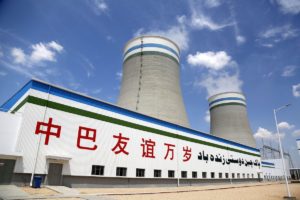China’s biggest provincial economy looks to be giving coal power the green light. Data gathered by the author indicates that last year 46.1 gigawatts of coal power capacity was in development in Guangdong. That’s more than in any other province and is roughly equivalent to the existing coal power capacity of South Africa, Indonesia or Germany.
Guangdong has sat at the top of the provincial GDP rankings for 34 years – reaching 12 trillion yuan (US$1.74 trillion) last year. As a national manufacturing centre, it is also out in front in terms of power consumption. Annual per-head consumption is over 6 megawatt-hours, ranking alongside developed nations such as Germany. Most of that power comes from coal, but is also reliant on large electricity imports from other provinces.
A review of public data on coal power projects found a significant speed-up in expansion: capacity in development in 2022 was 2.5 that being developed in 2020 and 3.5 times that in 2021. The vast majority of the 50 units in development were approved or announced last year. As of early this year, construction has started on one-third of those projects, which are due to be up and running between 2023 and 2025. Others were not yet being constructed, but expected to be in operation on a similar timescale. It looks as if Guangdong will see a new wave of coal power expansion during 2021–2025 (the 14th Five Year Plan, or FYP, period). This makes the province’s FYP plans for “strict controls on coal power projects and a gradual reduction of the percentage of coal power” look hard to achieve.
Guangdong’s development and reform authorities have said these approvals are in line with national and provincial policy on stabilising the economy, promoting investment and ensuring electricity supplies. The most commonly stated reasons for building these new coal power plants were: promoting economic growth; meeting increasing demand for electricity; peak regulation; and replacing less efficient coal plants.
The author does not believe large-scale expansion of coal power is a good solution for Guangdong to achieve those aims, and it may increase transition risks. Here, she analyses each of the above reasons individually.
Does coal power mean economic growth?
Of the 25 coal power projects in development in Guangdong last year, 19 were in part intended to help boost local economies. Such plants involve significant investment and have long lifespans. According to the feasibility study for a project to create two 1,000-megawatt generators in the city of Shanwei, investment will be in the region of 8 billion yuan (US$1.16 billion). When running, the project will contribute 560 million yuan in taxes to the local area, or about 20% of local tax income, the study estimates. Big coal power plants remain very tempting for local governments, particularly in underdeveloped areas. Total investments in coal power in Guangdong hit 189.7 billion yuan last year, and most of that went to underdeveloped parts of the province, such as Shaoguan, Jieyang, Shantou and Shanwei.
But falling utilisation rates for coal power plants, combined with rising costs of the fossil fuel, have seen many coal power firms lose money in recent years, and whether coal plants mean sustained economic growth is still up for debate. Coal power operations saw losses of 101.7 billion yuan in 2021, due to those high coal prices, according to the State-owned Assets Supervision and Administration Commission (SASAC). And according to BJX, an industry website, 40% of listed thermal power generators that published accounts for 2022 saw losses, with most of those losing over 2 billion yuan.
The optimistic profitability figures found in feasibility reports for new coal power plants mostly are based on an assumed utilisation rate of 5,000 hours per year and above. In fact, China Electricity Council data shows rates are trending downwards in the long-term, though have held steady at around 4,400 hours per year since 2015; for comparison, there are 8,760 hours in a year. Those figures will fall further as China brings more renewables online to help meet its dual carbon targets. Coal power plants may even be retired early. The long-term outlook for these investments is bleak. Moreover, 80% of the money being invested in coal power comes from bank loans. If the projects make losses, the owners may not be able to repay the loans and default rates may go up, possibly even leading to credit risk.
Is coal power needed to solve electricity shortages?
Almost all of Guangdong’s planned coal power plants stress that one of their aims is to help meet increasing demand for electricity. This ties up with electricity shortages seen both in Guangdong and elsewhere in China in recent years. In 2021, a combination of an economic recovery and high temperatures saw demand for electricity jump: between January and August it was 17.33% higher than the same period the previous year, a greater increase than the national average. In September, total power demand across Guangdong hit 141 gigawatts, more than any other provinces. Factories across Guangdong started staggering working hours, while some power-hungry firms simply stopped work or reduced output.
While Guangdong did not see widespread electricity shortages last year, the province of Sichuan did, in August. It looks like this prompted an uptick in coal power plant approvals in Guangdong, as authorities saw shortages in Sichuan as a warning. Between August and October, the provincial development and reform authorities approved nine major projects, with total planned generating capacity of 17.2 gigawatts.
The vast majority of coal power projects predict utilisation rates of 5,000 hours a year and higher. In reality, the average utilisation rate in Guangdong for coal plants since 2015 is around 4,000 hours, and hitting only 4,390 hours when supply was running short in 2021. It looks very likely that utilisation rates for those planned plants will be lower than hoped.
Much of China’s added demand for electricity is already met by renewables, and with wind and solar set to continue growing rapidly during the 14th Five Year Plan (FYP) period, it seems very unlikely that new coal power will be needed. This remains true in Guangdong. According to the province’s 14th FYP energy blueprint, total demand for electricity in 2025 is expected to be 880 TWh – 187TWh more than in 2020. But an additional 80.4 gigawatts of wind, solar, biomass, nuclear and natural gas power generation is planned, enough to generate 209 TWh of electricity, according to 2021 national figures on utilisation rates by power source – and enough to cover the growth in demand without resorting to new coal power.
Do renewables need to be bundled with coal?
Wind and solar power generation is intermittent, and its expansion will increase the need for peak regulation. Over half of the coal power projects in development in Guangdong last year mentioned this need. Those included 16 generator units of 1,000 megawatts or more.
There is no doubt that the expansion of wind power increases the need for flexibility and back-up capacity, but it is not clear to what extent that needs to be provided by coal, particularly by new gigawatt-scale generators. Guangdong is taking flexibility requirements seriously: in its plans for energy during the current FYP period, and for peaking carbon emissions, the provincial government has repeatedly said: changes to make existing coal power plants more flexible are needed; construction of planned pumped-storage hydroelectricity should be accelerated; new energy storage demonstrations and scaled applications should be put in place where suitable; and natural gas power plants should be built as appropriate in centres of demand, such as the Pearl River Delta.
Guangdong plans to have 2.4 gigawatts of new pumped-storage hydro capacity, and an additional 36 gigawatts of gas power plants during the 14th FYP period. By 2025, new energy storage capacity will be 2 gigawatts. By 2030, pumped-storage hydro will be over 15 gigawatts. Alongside supply-side measures such as these, peak regulation can also be helped by electricity transfers between provinces and demand-side response mechanisms. Detailed calculations and assessments are needed before we can be sure new coal power plants will still be needed once the above flexible capacity is online.
Even if coal power is needed, upgrading existing smaller facilities or extending their lifespans might provide more flexibility, be cheaper, and save energy and carbon emissions, when compared with building big new generators. In terms of flexibility, smaller generators can be fired up more quickly, while big generators have no advantages in stop-start times, ramp rate or minimum output. In economic terms, new facilities will have to repay financing costs, while existing plants have to spend less on servicing debt or depreciation. And while big generators are more efficient in terms of coal use under ideal conditions, efficiency falls considerably at lower levels of output, reducing their advantage in terms of per-kilowatt-hour coal burned and carbon emitted. Guangdong has plenty of coal-fired generators of 300 megawatts or under which have been in operation for 15 years or less. Refits and lifespan expansions would allow them to play their role in grid flexibility, making better use of that capacity.
Can upgrading large, and suspending small, coal plants decrease carbon emissions?
Efforts to phase out smaller thermal generator units in favour of 600-megawatt-plus units are also a factor; the point was mentioned by half of the coal power projects in development. The idea is to improve the coal power fleet – bigger generators, running with higher pressure steam, making generation cleaner and more efficient.
Yet the policy may end up increasing carbon emissions. According to Guangdong’s 2007 plans for shutting down smaller coal-fired generators, a new improved 600-megawatt generator would mean an existing generator of 420-megawatt capacity or more should be phased out. A 1,000-megawatt generator would mean an existing generator of 600 megawatts or more should be phased out. But in practice those aims were not achieved.
One power plant in the city of Zhanjiang built two new 600-megawatt supercritical generators, but only 298.03 megawatts of existing capacity was shut down. Far more capacity has been built under the policy than phased out. And many oil-fired power plants have been phased out, as well as coal-burning units, despite the fact that for any given amount of power generated, even the most advanced coal power plant will have higher emissions than an oil-fired one. Even swapping new coal power capacity for the equivalent of oil-fired generators would increase carbon emissions.
Coal power is no cure
Guangdong, a major provincial economy and a heavy electricity user, hopes to use coal power to boost economic growth, meet rising electricity demand, ensure electricity supplies, and even to promote energy-saving and emissions-reductions. The reality is that coal power is not the answer. On the contrary, its continued expansion will increase investment costs, energy transition costs, and climate and environmental costs. The drive for high-quality development, and the national target to peak carbon emissions before 2030 and reach carbon neutrality before 2060, mean the most cost-effective way of meeting the above goals is to exploit value from existing capacity and actively develop renewables and energy storage. We must think again about expanding coal power.
The author would like to thank Yang Li, Yao Zhe, Joanna Lewis and Cui Xueqin for their valuable advice and suggestions on this article, and Global Energy Monitor for providing data.










